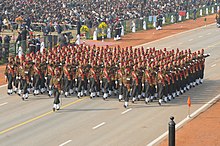| Bengal Engineer Group | |
|---|---|
 | |
| Active | 1803–present |
| Country | |
| Allegiance | Republic of India (historically: Bengal Army; Indian Army) |
| Branch | Corps of Engineers |
| Role | Military engineering |
| Regimental Centre | Roorkee, Uttarakhand |
| Nickname(s) | Bengal Engineers, Bengal Sappers |
| Motto(s) | God's Own |
| Colors | Presidential Colours of India |
| Anniversaries | 7 November |
| Decorations | 11 Victoria Cross 116 Indian Order of Merit 1 Padma Bhushan 17 Shaurya Chakra 93 Sena Medals 11 Arjun Award |
| Battle honours | 80 11 Theatre honours |
| Commanders | |
| Colonel Comdt of Bengal Sappers | Lt Gen Harpal Singh, AVSM, VSM[1] |
| Colonel of the Regiment | Lt Gen S. K. Srivastava Engineer - in - Chief[2] |
| Notable commanders | Lt Gen J. S. Dhillon, Padma Bhushan, PVSM Lt Gen K. N. Dubey, PVSM |
The Bengal Engineer Group (BEG) (informally the Bengal Sappers or Bengal Engineers) is a military engineering regiment in the Corps of Engineers of the Indian Army. The unit was originally part of the Bengal Army of the East India Company's Bengal Presidency, and subsequently part of the British Indian Army during the British Raj. The Bengal Sappers are stationed at Roorkee Cantonment in Roorkee, Uttarakhand.
The Bengal Sappers are one of the few remaining regiments of the erstwhile Bengal Presidency Army and survived the Rebellion of 1857 due to their "sterling work" in the recapture by the East India Company of Delhi and other operations in 1857–58. The troops of the Bengal Sappers have been a familiar sight for over 200 years in the battlefields of British India with their never-say-die attitude of Chak De and brandishing their favourite tool the hamber.[3][4][5]
Over the years the Bengal Sappers have won many battle and theatre honours, 11 Victoria Cross, 116 Indian Order of Merit, 17 Shaurya Chakra, 93 Sena Medals and 11 Arjun Awards, the highest number of won by any single organization in the country.[3][6] Lt Gen Joginder Singh Dhillon was commissioned into Bengal Engineer Group in 1936 and commanded the First Republic Day Parade in New Delhi,[citation needed] becoming the first army officer to be awarded the Padma Bhushan in November 1965.[7] Among the three Sapper units of the Indian Army, the Bengal Sappers was the first engineer group to receive the 'President Colours' in recognition of its service to the nation, on 12 January 1989, by Ramaswamy Venkataraman, the eight President of India, who presented the Regimental Colours to Bengal Engineer Group at Roorkee.[5]
Besides service on the battlefield, the Bengal Engineers also rendered valuable peacetime contributions. The military engineer Lt. James Agg designed St John's Church, Calcutta. It was based on James Gibbs's St Martin-in-the-Fields in London and was consecrated in 1787.[8] St John's was the Anglican cathedral of the city – capital of the Bengal Presidency – until St Paul's Cathedral, begun 1839, was completed in 1847.[9] St Paul's was also designed by a Bengal Engineer, William Nairn Forbes, who was also architect of the "Old Silver Mint" building at the India Government Mint, Kolkata, basing its portico on the Parthenon on the Acropolis of Athens.[9]

- ^ "Gazette of India No 45" (PDF). 7 November 2020. Retrieved 24 November 2020.
- ^ "Gazette of India No 45" (PDF). 7 November 2020. Retrieved 24 November 2020.
- ^ a b Bengal Sappers' saga of valour The Tribune, 24 November 2008.
- ^ Bengal Sappers: 'Sarvatra' for Two Hundred Years Sainik Samachar, Vol. 50, No. 21, 1–15 November 2003, 10-24 Kartika, 1925 (Saka), Ministry of Defence, Govt. of India.
- ^ a b Corps of Engineers, Indian Army bharat-rakshak.com. Archived 25 September 2008 at the Wayback Machine
- ^ Bengal Engineering Group Archived 1 February 2009 at the Wayback Machine Haridwar Official website.
- ^ Unique Achievements Archived 15 September 2008 at the Wayback Machine Bengal Sappers.
- ^ "Churches in Kolkata". Archived from the original on 3 August 2012. Retrieved 25 January 2011.
- ^ a b Curl, James Stevens; Wilson, Susan, eds. (2015), "Forbes, William Nairn", A Dictionary of Architecture and Landscape Architecture (3rd ed.), Oxford University Press, doi:10.1093/acref/9780199674985.001.0001, ISBN 978-0-19-967498-5, retrieved 30 June 2020